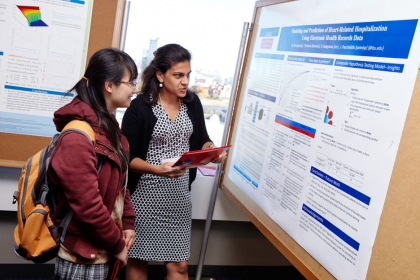Wuyang Dai receives the College of Engineering 2015 Societal Impact Dissertation Award
Wuyang Dai, a 2015 graduate of NOC, received the College of Engineering 2015 Societal Impact Dissertation Award for his thesis "Detection and Prediction Problems with Applications in Personalized Health Care."
The thesis developed algorithmic methods to support personalized preventive medicine. One of the problems addressed is the prediction of hospitalizations due to heart disease based on a patient's Electronic Medical Record. Analyzing records of more than 45,000 Boston Medical Center patients, the new algorithms predict about 80% of hospitalizations with few false positives. Prediction enables prevention which can improve outcomes and reduce the more than $9B spent annually in the US on preventable heart-related hospitalizations.
Big Data Improving Health Care
Data scientist and physician team up to reduce preventable hospitalizations
By Suzanne Jacobs, BU Research
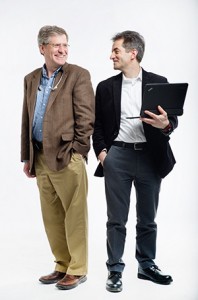
Big Data Meets Healthcare: Bill Adams, a physician and medical informatician, and Yannis Paschalidis, a data scientist and engineer, are working together to use data from electronic health records to reduce preventable hospitalizations and cut health care costs. Photo by Jackie Ricciardi
Big Data Meets Healthcare: Bill Adams, a physician and medical informatician, and Yannis Paschalidis, a data scientist and engineer, are working together to use data from electronic health records to reduce preventable hospitalizations and cut health care costs. Photo by Jackie Ricciardi
Professor Yannis Paschalidis (ECE, SE, BME), a data scientist, has built a career on making things run smoothly and efficiently—transportation systems, communication networks, supply chains, sensor networks—and now he’s taking on perhaps his most ambitious challenge yet: the US health care system.
It all started about three years ago. Paschalidis, a Distinguished Faculty Fellow at Boston University’s College of Engineering (ENG), read in a study by the US Department of Health and Human Service’s Agency for Healthcare Research and Quality (AHRQ) that in 2006, the US spent about $30.8 billion on hospitalizations that could have been prevented through better patient care, healthier patient behavior, or improved ambulatory services.
“I was reading a lot of things about the sorry state of the health care system in the US and how inefficient it is, and I thought it’s an opportunity to do something,” says Paschalidis, who also directs BU’s Center for Information & Systems Engineering. “I thought people like me that have a quantitative, more optimization-oriented background could contribute something.”
And so, having never worked in medicine before, Paschalidis teamed up with William G. Adams, a Boston Medical Center (BMC) physician and BU School of Medicine professor of pediatrics. With a team of graduate students and nearly $2 million from the National Science Foundation, the two set out to build a piece of software that could automatically flag patients at increased risk for medical emergencies by using data from their electronic health records (EHRs). They decided to start with heart diseases, which alone cost the US more than $9.5 billion in preventable hospitalizations in 2006, according to the AHRQ study.
To understand how Paschalidis works, think of how an autopilot controls an airplane. As a plane flies, autopilot software takes in data about its position and uses that data to adjust the plane’s trajectory as necessary. It’s a constant flow of data intake, analysis, and feedback. Similarly, when Paschalidis sets out to improve, say, a network of sensors, he and his research team write computer software that takes in data about how the system is working and then finds ways to correct or improve it.
In this project, hospital patients are the systems.
Fortunately, EHRs offer plenty of data—test results, diagnoses, prescriptions, emergency room (ER) visits, previous hospitalizations, demographic information. It’s far too much for doctors and nurses to comb through manually, but enough to feed an algorithm that automatically processes the information and flags at-risk patients. The software works by sifting through records of patients who were previously hospitalized and learning which risk factor—a certain number of chest complaints or an unusual level of a particular enzyme in the heart, for example—might have been red flags. The algorithm then uses those red flags to warn of future hospitalizations.
The challenge for Paschalidis was understanding how to properly use medical data and how to incorporate this kind of software in an actual hospital. That’s where Adams comes in.
A pediatrician and medical informatician (someone who uses information technology to improve health care), Adams has spent the past 20 years thinking about how to use data from EHRs to improve patients’ health outcomes, especially among families in Boston’s urban communities. He’s also one of the lead scientists at BU’s Clinical & Translational Science Institute (CTSI), one of 60 such sites across the country that aim to accelerate medical advances by encouraging researchers in disparate fields to collaborate on medical research.
“This is a perfect example of translational research collaboration,” Adams says. “Yannis and his lab have exceptional skills in data mining that we don’t have, but we have extraordinary data and clinical expertise.”
To use that data, Paschalidis and his team first needed a crash course in medical terminology to make sure they understood what they were working with. Much of EHR data is contained in a kind of “clinical language” that only doctors understand, Adams says. Sometimes, he says, even the same term can have different meanings, depending on the context in which the doctor records it. For example, a diagnosis of hypertension (high blood pressure) can be recorded as either a diagnosis made during a visit or a problem on the patient’s problem list. Both could be recorded with the same code (ICD-9 401.9), but users would need to know to look further to decide which of the two meanings the data represents. Cleaning up “messy” data—figuring out what it means, what to use, and how to represent it in the software—is time-consuming but important, Paschalidis says. “If you fit garbage to an algorithm,” he says, “you’ll get garbage as output.”
The researchers remove any identifying information from the EHRs using open-source software from a National Institutes of Health-funded center at Harvard University called i2b2 (Informatics for Integrating Biology & the Bedside).
Once the data is cleaned up and anonymized, Paschalidis and his graduate students can enter it into their software. The algorithm they built classifies patients as either at risk or not at risk for heart-related hospitalizations within one year. An elderly patient or someone who visited the ER in the previous year, for example, might be at risk, while a younger person who hasn’t been to the hospital in a few years might not be at risk. How the algorithm will ultimately present this information to doctors is still under development.
To test the software, Paschalidis and his students collected the EHRs of just over 45,500 patients from BMC. They used about 60 percent of the records to train their so-called machine learning software, teaching it which factors had put patients at risk for hospitalizations in the past. Then, they used the remaining data to test the software’s ability to make predictions. They found that it could correctly predict up to 82 percent of heart-related hospitalizations, while falsely predicting hospitalizations in about 30 percent of patients who weren’t actually at risk. Paschalidis says that it’s possible to reduce the number of false predictions, but doing so would correspondingly lower the number of accurate predictions. A false prediction rate of 10 percent, for example, would correspond to an accurate prediction rate of 65 percent.
“In medicine, we’re constantly trying to balance between something that’s concerning and something that might be a false positive,” Adams says. In many cases, however, the recommendations that would come of a false positive—healthy eating, exercise, an extra check-in with the doctor, extra visits from a nurse—could still benefit the patient. And, Paschalidis says, preventing hospital visits that each cost thousands of dollars is worth the occasional unnecessary checkup that only costs a couple hundred dollars.
Adams and Paschalidis published their findings about the machine learning software’s success in predicting heart-related hospitalizations in March 2015 in the International Journal of Medical Informatics. Their co-authors included Professor Venkatesh Saligrama (ECE, SE); Wuyang Dai and Theodora Brisimi, ENG PhD students working with Paschalidis; and Theofanie Mela, a cardiologist at Massachusetts General Hospital.
“If coupled with preventive interventions, our methods have the potential to prevent a significant number of hospitalizations by identifying patients at greatest risk and enhancing their patient care before they are hospitalized,” the researchers write in the study. “This can lead to better patient care, but also to substantial health care cost savings. In particular, if even a small fraction of the $30.8 billion spent annually on preventable hospitalizations can be realized in savings, this would offer significant results.”
Ultimately, Adams says, having this kind of ongoing, automated analysis within electronic medical records could not only help doctors, nurses, and case managers monitor their patients more effectively, it could also elucidate disease risk factors previously undetected by doctors.
“All of us know that a serious problem like diabetes is always going to increase your likelihood of being admitted to the hospital,” Adams says, “but the trick is to determine whether it’s about the thing that’s happening to your diabetes or something else unrelated to your diabetes that has substantially increased the likelihood of being hospitalized. The machine learning software has the potential to learn new associations.” These could be associations between some clinical features that make it more likely for the patient to develop serious complications from diabetes.
In the coming year, Paschalidis and Adams will be interviewing doctors, trying to figure out how best to put this kind of predictive software to work in an actual hospital.
“I’m confident that it will work,” Paschalidis says. “The issue is, what is the best way of incorporating something like that in the practice? Will the doctors use it or ignore it?”
Eventually, Paschalidis says, he’d like to expand the software to predict other, non-heart-related hospitalizations. He’s also currently working with BMC’s surgery department on software designed to flag patients at risk for readmission within 90 days, so hospitals could perhaps monitor those patients more closely. The 90-day window is of particular interest to hospitals because Medicare doesn’t reimburse for readmissions within that timeframe.
Down the road, Paschalidis says, it might also be possible to use data from wearable technologies in addition to EHR data. The data is there, he says; it’s just a matter of getting access to it.
“We carry these smartphones and now these smart watches and all of these fitness trackers and other devices that know much more than the hospital knows about our state of health,” he says. “You now have a much richer record about the patient, and the richer the record is, the better prediction you can make.”
Throughout his career, Paschalidis has put his data analysis skills to use in a lot of different areas. For the past three years, he’s been applying those skills to developing sensor networks for “smart cities.” He says he thinks he’ll be working in health care for a while.
“I feel that health care is an important area,” he says, “and the contributions that you make are somehow more tangible in terms of the potential outcome.”
The story was originally published at BU research and was highlighted as News from the Field by the National Science Foundation.
Boston is Becoming a “Smart City” with ENG Support
IBM & IEEE recognize ECE & SE research contributions that are expected to improve urban life in Boston.
By Gabriella McNevin

Ushered in with the 21st century, are challenges that require real technological innovations. The global population is growing and, like magnets, people are moving to cities. According to the UN, by 2030, 60% of the population will live in a city, and by 2050, 70% (source). City officials are taking measures to adapt to the steadily increasing population. Today, Boston is zeroing in on population sustainability issues that threaten driver safety and drain energy: Inadequate road infrastructure and an antiquated repair system.
As part of a multifaceted collaboration to create technology to solve urban problems, the City of Boston and a Boston University-led team of researchers have developed equipment to improve the local thoroughfare, called “Street Bump.”
IBM and IEEE has recognized “Street Bump” as a significant contribution to Boston, and have presented the developers the second place prize in “IBM Students for a Smarter Planet/IEEE Smarter Planet Challenge: Student Projects Changing the World.” The team’s project, entitled,“Street Bumps and Big Data Analytics: Crowdsourcing Our Way to Better Roads,” demonstrates engineering expertise and a commitment to improving the world.
The team of researchers includes graduate students Theodora Brisimi (ECE), Yue Zhang (SE), Wuyang Dai (ECE), Setareh Ariafar (SE) and Nicholas Baladis (MIT). Professor Christos Cassandras (ECE, SE) and Professor Ioannis Paschalidis (ECE, SE, BME) are team advisors. All BU researchers are affiliated with the Center for Information and Systems Engineering.
The project focuses on an iPhone app – “Street Bump” – developed by the City of Boston to collect data on road conditions. The app is used by city employees and many citizens and was designed to facilitate crowdsourcing in collecting relevant road condition data. It uses the iPhone’s accelerometer to detect “bumps” sensed during a trip. The app then transmits the data to the City of Boston. The information can be used to alert repair crews of road damage. The algorithms developed by the BU-led team analyze the data received by the City and classifies the detected bumps into “actionable” and “non-actionable.” Severe bumps like potholes are actionable and can be prioritized in scheduling repairs.
In this work, the team collaborated with The City of Boston’s Office of New Urban Mechanics, which provided actual data from the City’s servers. Office Co-Chair Nigel Jacob and Chris Osgood have echoed the Office’s website saying, “there is a revolution going on in how cities are designed & built. This new focus on technology infrastructure and sustainable design links how a city is built with how it is managed and experienced.”
“Street Bump” is the second smart city application Professor Casssandras has advised that received national attention. The first app, Smart Parking, also won 2nd place in the “IBM Students for a Smarter Planet/IEEE Smarter Planet Challenge: Student Projects Changing the World” competition in 2011.
CISE Hosts International Symposium on Control of Network Systems
Attendees Celebrate New IEEE Journal Edited by ENG’s Paschalidis
By Mark Dwortzan
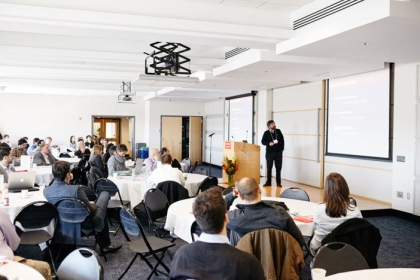
Professor Christos Cassandras (ECE, SE) describing a strategy to maximize battery lifetimes in wireless sensor networks at SCONES, held October 27-28 in the Photonics Center Colloquium Room (Photos by Dave Green)
Microbes are all around us—even inside us—and that’s a good thing. Left alone, these tiny organisms have a huge impact on everything from human health to wastewater treatment. But with a little engineering, they could do even more. In certain environments, their metabolic processes could be exploited to make biofuels, vaccines and other useful products and services. To tap their potential,Associate Professor Daniel Segrè (Biology, BME, Bioinformatics) and collaborators have developed mathematical models to predict the metabolic interactions that occur among different microbial species under varying environmental conditions, and to design new microbial networks with desired properties.
Segrè presented his research at the first Symposium on the Control of Network Systems (SCONES), held on October 27-28 in the Photonics Center Colloquium Room.
Sponsored by the IEEE Control Systems Societyand the Center for Information and Systems Engineering at Boston University, SCONES celebrated the inaugural March 2014 issue of theIEEE Transactions on Control of Network Systems (TCNS), a new IEEE Transactions journal edited by Professor Yannis Paschalidis (ECE, BME, SE) focused on problems related to the control, design, study, engineering, optimization and emerging behavior of network systems.
“We live in a world that is extremely interconnected,” said Paschalidis, the journal’s editor-in-chief. “This is also true of systems, biological or manmade, that support our modern way of life. Networks, which both connect system components and influence how they function as a whole, are increasingly the focus of leading edge research, and this is the impetus forTCNS and SCONES.”
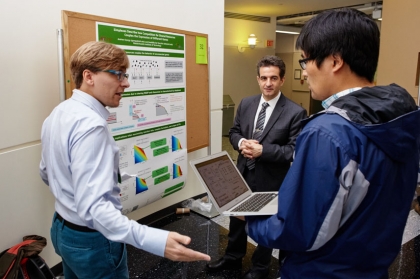
TCNS Editor-in-Chief Professor Yannis Paschalidis (ECE, SE, BME) (center) with MIT PhD student Andras Gyorgy (left) and another SCONES participant (right) during a poster session.
One author of each paper in the inaugural issue presented at the symposium, along with talks and posters from several other researchers in the field. Representing major research institutions from around the world, SCONES presenters explored the analysis, control and optimization of electric power, computer, communication, transportation, biological, cyber-physical, social and economic networks. As if bringing the TCNS journal to life, the 23 featured speakers illustrated complex concepts with a flurry of equations, algorithms, graphs and diagrams.
“TCNS aspires to become the premiere destination for mathematically rigorous work in network systems,” said Magnus Egerstedt, an ECE Professor at Georgia Tech and the TCNS deputy editor-in-chief—and the SCONES presenters lived up to that promise.
In addition to Segrè, two other Boston University researchers shared highlights of papers they co-authored in the inaugural issue of TCNS on resource allocation and routing, the selection of optimal path by which to transmit information across the nodes of a network.
Professor Lev Levitin (ECE, SE) presented an alternative to wormhole routing, a widely used routing technique that’s prone to deadlock—multiple messages getting blocked by one another in a vicious cycle—under heavy computer network traffic. Levitin described a series of new, high-performance algorithms that he, Professor Mark Karpovsky (ECE) and ECE Visiting Researcher Mehmet Mustafa developed to break such cycles and prevent deadlock formation during routing and thus preserve network connectivity.
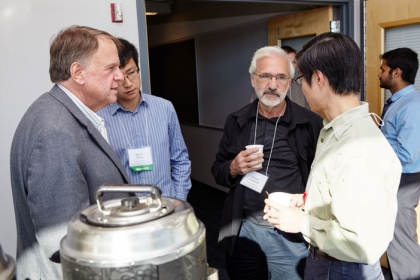
Professor Michael Caramanis (ME, SE) (second from right), who chaired the symposium’s first session on control and optimization of electric power networks, with University of Maryland Professor John Baras (ECE) (left), BU Systems Engineering PhD student Bowen Zhang (second from left) and California Institute of Technology Professor Steven Low (ECE) (right) during a break.
Professor Christos Cassandras (ECE, SE) presented an optimal control strategy that he, Tao Wang (SE, PhD’13) and Sepideh Pourazarm (SE, PhD candidate) devised to maximize the lifetime of sensor batteries deployed at each node of a wireless sensor network for surveillance, environmental monitoring or other applications where human intervention may be inconvenient or costly.
“Because every node has limited energy, you have to worry about the battery dying and the network ceasing to function,” said Cassandras, “so you need to focus on battery lifetime.”
Modeling each battery as a dynamic system in which energy does not dissipate in a linear fashion, the strategy uses an algorithm to determine the routing scheme that will minimize that energy loss.
The symposium, which was well-attended and featured many fruitful exchanges between speakers and attendees, signified how well the TCNS journal has been received by the international research community, Paschalidis observed.
“In the first three TCNS issues published in 2014, we have seen papers covering many types of network systems, from networked control and multi-agent systems, to communication, transportation, electric power, biological and social networks,” he noted. “SCONES is playing a key role in coalescing a community of researchers around the journal.”
BU Bringham & Women’s Hospital Partnership Celebrates First Year
Joint Research Focused on Medical Imaging and Image-Guided Interventions
By Mark Dwortzan
 Researchers from Boston University and Brigham & Women's Hospital are collaborating to improve medical imaging and image-guided interventions. (Images courtesy of Brigham & Women's Hospital)
Researchers from Boston University and Brigham & Women's Hospital are collaborating to improve medical imaging and image-guided interventions. (Images courtesy of Brigham & Women's Hospital)
Boston University College of Engineering Assistant Professor Darren Roblyer (BME) and Brigham & Women’s Hospital radiologist Srinivisan Mukundan are exploring a strategy that combines a new optical imaging device developed by Roblyer with emerging magnetic resonance imaging (MRI) techniques to probe malignant brain tumors during chemotherapy treatment. Their research could enable clinicians to monitor the effectiveness of chemotherapy over the course of treatment and implement changes to chemotherapy drugs and dose levels as needed.
The project is one of five now receiving funding through an ongoing partnership between Boston University and Brigham & Women’s Hospital. On September 12 at the BU Photonics Center, Dean Kenneth R. Lutchen and Dr. Steven Seltzer, Chair of the BWH Department of Radiology, announced the second year of the partnership, which has already provided one year of seed funding to projects ranging from image-guided cancer drug delivery to early detection of heart disease.
 “The goal is to leverage synergies between Brigham & Women’s Hospital’s Radiology Department in imaging and image-guided interventions with the College of Engineering’s strengths in developing new materials and technologies as well as novel techniques for processing images and large data sets,” said Associate Professor Tyrone Porter (ME, BME, MSE), who is coordinating the partnership. “The hope is to stimulate research collaborations between the two campuses and develop a National Institutes of Health training program in clinical imaging and image-guided interventions.”
“The goal is to leverage synergies between Brigham & Women’s Hospital’s Radiology Department in imaging and image-guided interventions with the College of Engineering’s strengths in developing new materials and technologies as well as novel techniques for processing images and large data sets,” said Associate Professor Tyrone Porter (ME, BME, MSE), who is coordinating the partnership. “The hope is to stimulate research collaborations between the two campuses and develop a National Institutes of Health training program in clinical imaging and image-guided interventions.”
The brainchild of Lutchen and Seltzer, the BU-BWH partnership brings together world-class expertise and equipment from Boston University entities such as the BU Photonics Center and the BU Center for Nanoscience & Nanobiotechnology, and from the BWH Department of Radiology, home to the National Institutes of Health’s National Center for Image-Guided Therapy and the Advanced Multimodality Image Guided Operating Suite (AMIGO). Joint research between the two campuses could result in less invasive, more accurate medical imaging and image-guided interventions.
“There’s no question that in so many dimensions, imaging is at the foundation of a tremendous amount of potential breakthroughs in medical discoveries and practice, but there are huge challenges from a scientific and technical point of view,” said Lutchen. “We’ve got tons of interested students and faculty here that need and want to use imaging technologies to address interesting and important questions.”
First-round projects include the engineering of a new “molecular imaging” MRI contrast agent for detecting early calcification of the aortic valve; the combination of ultrasound and MR data to evaluate the elastic properties of tissues, which are associated with pathological indicators of disease; a clinical decision support system for patient-specific cancer diagnosis and management; and ultrasound-guided delivery of chemotherapy drug-laden nanoparticles to metastasized lung cancer cells in the brain. Applications for second-round projects are now underway.
All projects involve at least one principal investigator from each of the partnering institutions, who jointly advise a doctoral student on a project that could positively impact clinical practice. Participating ENG faculty include Professors Joyce Wong (BME, MSE), Paul Barbone (ME, MSE), Venkatesh Saligrama (ECE, SE) and Yannis Paschalidis (ECE, SE); Associate Professor Porter; and Assistant Professor Roblyer.
“The fields of biomedical imaging and bioengineering have been converging and collaborating for decades, and that collaboration continues to get closer and closer,” said Seltzer, noting a burgeoning clinical need for advanced technologies in functional and molecular imaging; information technologies ranging from data mining to image processing; and minimally-invasive diagnostic and therapeutic procedures guided by high-technology imaging techniques.
IEEE Control Systems Magazine Profile
Yannis Paschalidis was profiled in the June 2014 issue of the IEEE Control Systems Magazine. Read the full story.
Top Ranked ENG Algorithms Could Reveal New Cancer Drug Target
by Mark Dwortzan
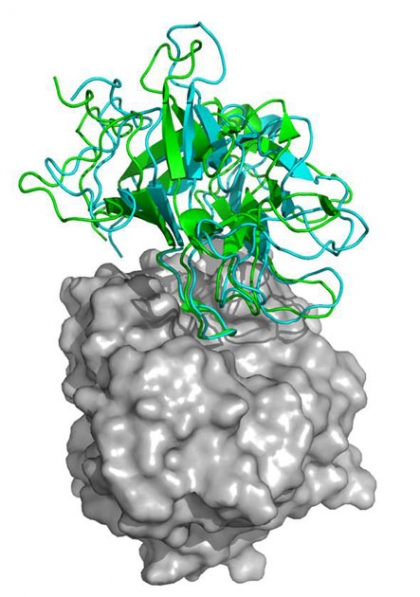
An interdisciplinary College of Engineering team has developed computational methods to predict the structures that form when two cellular proteins interact. Judged the world�s best at a major international competition, these methods have drawn more than $3 million in NIH funding.
An interdisciplinary College of Engineering team has developed computational methods to predict the structures that form when two cellular proteins interact. Judged the world's best at a major international competition, these methods have drawn more than $3 million in NIH funding.
An interdisciplinary team of College of Engineering faculty members—Professor Sandor Vajda and Research Assistant Professor Dima Kozakov (both BME), Professor Ioannis Paschalidis (ECE) and Associate Professor Pirooz Vakili (ME)—has developed a family of powerful optimization algorithms for predicting the structures of complexes that form when two cell proteins bond together—structures that, in some cases, generate erroneous cell signaling pathways that can trigger cancer and other inflammatory diseases. Recognizing the promise of these computational methods to advance new approaches to combating these illnesses, the National Institutes of Health (NIH)-National Institute of General Medical Sciences (NIGMS) recently approved a $1.6 million, five-year grant that will enable the researchers to continue refining them.
A joint effort of Boston University’s Center for Information and Systems Engineering and Biomolecular Engineering Research Center, the project combines Paschalidis’ and Vakili’s expertise in optimization and systems theory with Vajda and Kozakov’s knowledge of biophysics and bioinformatics.
“Given the three-dimensional structure of two proteins, you’d like to predict with great accuracy the structure of the complex formed once these two proteins bind,” said Paschalidis, who compares the process to characterizing all the possible structures that pairs of Lego blocks can form out of an initial set of 1,000 blocks. “Based on laws of thermodynamics, we’ve developed optimization algorithms that have succeeded in doing just that.”
Applying those high-precision algorithms to a related effort, Vajda and Kozakov are also collaborating with BU Associate Professor Adrian Whitty, Professor John Porco, Professor Karen Allen, and Research Assistant Professor Aaron Beeler (all Department of Chemistry); and Professor Gilmore (Department of Biology) to identify small molecules—potential drugs—that can disrupt protein-protein interactions (PPIs) that produce structures that may provoke illness.
Operating under a separate, four-year, $1.6 million NIH-NIGMS grant, the BU team aims to develop synthetic molecules that inhibit PPI targets at sites identified by Vajda’s and Kozakov’s innovative computational approaches—without introducing any harmful side effects. In particular, the researchers are attempting to design novel molecules that can block chronically hyperactive cell signaling pathways found in human inflammatory diseases and cancers.
Despite decades of effort by the pharmaceutical industry, it has proven extraordinarily difficult to develop oral drugs that inhibit PPIs, Vajda observed. “Current protein-based drugs can disrupt PPIs, but only on the surface of cells,” he said. “But 90 percent of PPIs occur within the cell, and these are the interactions that we’re working to disrupt.”
ENG Algorithms Judged the World’s Best
The NIH is funding the development and application of these advanced computational methods because scientists cannot easily observe the complexes formed by protein-protein interactions. Many biologically important PPIs produce fragile complexes that do not remain intact long enough to be subject to direct experimental analysis, but optimization algorithms such as those developed by the ENG team can determine the structure of these complexes with great accuracy based on the structures of the component proteins.
As the team improves its methods, they will ultimately be incorporated into Vajda’s and Kozakov’s protein-protein docking server ClusPro, a website to which any user can submit the three-dimensional coordinates of two proteins and receive a supercomputer-calculated prediction of the structure of the complex formed by those proteins. ClusPro has been used by over 3000 research groups worldwide, and generated over 100 structures reported in the scientific literature.
In a worldwide blind prediction experiment conducted by CAPRI (Critical Assessment of Predicted Interactions) in Barcelona last December, judges determined that the ENG team’s computational methods delivered the best performance in modeling selected protein-protein complexes when compared against 64 other predictor groups that combine software models with human analysis, and that ClusPro also performed better than nine other competing automated docking servers, which rely on software alone. Results of the CAPRI experiment will be published in a special issue of the journal Proteins: Structure, Function, and Bioinformatics in November.
Interdisciplinary Team Sheds Light on How Proteins Bind
Finding Could Open Up New Drug Discovery Opportunities
By Mark Dwortzan
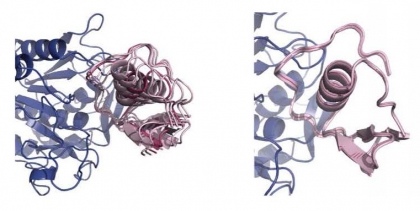
"Transient encounter complexes" of an enzyme produced by a bacterium present in the human gut binding to a fragment of a protein in turkey eggs which inhibits the enzyme.
Over the past six years, an interdisciplinary team of College of Engineering faculty members—Professor Sandor Vajda (BME, SE), Research Assistant Professor Dima Kozakov (BME), Professor Yannis Paschalidis (ECE, SE) and Associate Professor Pirooz Vakili (ME, SE)—have been developing a set of powerful optimization algorithms for predicting the structures of complexes that form when two proteins bind together—structures that, in some cases, generate erroneous cell signaling pathways that can trigger cancer and other inflammatory diseases.
Incorporated into Vajda’s and Kozakov’s protein-protein docking server ClusPro—a website to which any user can submit the three-dimensional coordinates of two proteins and receive a supercomputer-calculated prediction of the structure of the complex formed by those proteins—these algorithms have enabled more than 3,000 research groups across the globe to better understand the inner-workings of the cell and explore potential drug targets without having to run expensive, time-consuming lab experiments.
Now the research team behind these algorithms has, through lab experiments and computational analysis, obtained a sharper understanding of how two proteins come together to form a complex, and plans to apply that knowledge to boost the speed and accuracy of ClusPro’s predictions. They and collaborators from the Hebrew University of Jerusalem and the National Institutes of Health (NIH) report on this new development in a new article in eLife, an open source journal for outstanding biomedical research.
A joint effort of Boston University’s Center for Information and Systems Engineering and Biomolecular Engineering Research Center supported by a five-year, $1.6 million grant from the NIH, the project combines Paschalidis’ and Vakili’s expertise in optimization and systems theory with Vajda and Kozakov’s knowledge of biophysics and bioinformatics.
“The research was a beautiful combination of physics with mathematics,” said Paschalidis. “We leveraged techniques popular in control systems developed to describe movement of complex 3-D objects, such as a robot arm, as well as machine learning methods used to analyze large data sets.”
“Preventing proteins from binding to the wrong partners is an increasingly prominent concept in drug design,” said Janna Wehrle, PhD, of the NIH National Institute of General Medical Sciences, which partially funded the research. “These new computational methods developed by the Boston University team will help researchers quickly discover both healthy protein pairs and disease-causing pairs that we might want to break up.”
Until now, scientists were unable to characterize how protein-protein complexes form from two individual proteins—each analogous to a distinctly-shaped Lego block—because their interactions from the moment they come in contact to the moment they “snap into place” were too fast to detect. But an emerging nuclear magnetic resonance (NMR) technique has made it possible to track their rapidly changing configurations from rendezvous to docking using radio waves.
Applying this technique, the College of Engineering team determined that its protein-protein docking algorithms were already generating these exact transitional states, but labelling them as “false positives” alongside the correctly identified final protein-protein complex.
“What we have so far been calling false positives are ‘transient encounter complexes,’ temporary structures the proteins form as they ‘search’ for the one orientation that will enable them to bind successfully,” said Paschalidis.
All protein-protein encounter complexes are characterized by low energy, with the lowest energy expected to occur at the final, stable complex. By systematically analyzing the energy values corresponding to the transient complexes, the researchers found that with each successive interaction, the intersecting proteins have fewer and fewer ways to twist and turn, thereby accelerating their path to binding. This explains how two proteins can dock very quickly despite the many nooks and crannies that must line up to seal the deal.
The College of Engineering team next aims to exploit its findings to make its docking algorithms faster and more accurate. The researchers also plan to examine the implications of their work for protein-DNA and protein-small molecule interactions that are important in genetic regulation and drug discovery, respectively.
See movie of transient protein-protein encounter complexes.
Three ECE Profs Named as IEEE Fellows
Professors W. Clem Karl (ECE, BME, SE), Theodore Moustakas (ECE, MSE) and Yannis Paschalidis (ECE, SE) have been named as 2014 IEEE Fellows, the highest grade of membership in the world’s leading professional association for advancing technology for the benefit of society.
The IEEE confers the grade of Fellow upon individuals with outstanding records of accomplishment in any of the organization’s fields of interest, which range from aerospace systems, computers and telecommunications to biomedical engineering, electric power and consumer electronics. Less than 0.1 percent of voting members—the IEEE currently has 400,000 members in 160 countries—are selected annually for this member grade elevation, considered a major career achievement and prestigious honor across the technical community.
W. Clem Karl
Karl was recognized for his contributions to “statistical signal processing and image reconstruction.” He hasdeveloped several statistical models for the extraction of information from diverse data sources in the presence of uncertainty, and applied them in projects that include automatic target detection and recognition for synthetic aperture radar; locating oil deposits and analyzing the earth’s atmosphere; and monitoring medical conditions using tomography and MRI.

“This is a great honor, and I’m humbled that my peers would confer it on me,” said Karl.
A member of the BU faculty since 1995, Karl has assumed many leadership roles for the IEEE. Currently editor-in-chief of IEEE Transactions on Image Processing, he is a member of the Board of Governors and Conference Board of the Signal Processing Society; the Transactions on Medical Imaging Steering Committee; the Biomedical Image and Signal Processing Technical Committee; and the Technical Committee Review Board. He has co-organized IEEE workshops on statistical signal processing and bioinformatics, and was general chair of the 2009 IEEE International Symposium on Biomedical Imaging.
Among other things, Karl is developing methods to improve the detection of explosives in luggage. The technology could increase passenger safety while reducing delays and other inconveniences for air travelers, such as having to remove laptops and other electronic devices from bags.
Theodore Moustakas
Moustakas was recognized for his contributions to “the epitaxial growth of nitride semiconductors.” He is a trailblazer in molecular beam epitaxy, a versatile and advanced thin-film growth technique used to make high-precision, nitride (nitrogen compound-based) semiconductor materials used in fiber-optic, cellular, satellite and other applications.

His most notable achievements include pioneering the nucleation steps for the growth of gallium nitride on sapphire and other substrates, an essential process for the manufacture of blue LEDs, which are widely used in solid state lighting applications; and developing highly-efficient, deep ultraviolet (UV) LEDs, which are expected to provide environmentally friendly water and air purification.
“I am delighted to receive this prestigious award and I am very grateful to many of my collaborators at BU and other institutions, as well the outstanding past and current students that I have had the fortune of mentoring,” said Moustakas.
A member of the ENG faculty for more than 30 years and ENG Distinguished Scholar who helped shape the Materials Science & Engineering Division, Moustakas has had a broad impact on his field, through 25 patents, hundreds of invited talks and journal papers and 10,000 citations in research literature. Recently selected as the recipient of the Molecular Beam Epitaxy (MBE) Innovator Award, he is also a Fellow of the American Physical Society and Electrochemical Society, and Charter Fellow of the National Academy of Inventors. In 2013 he was named the Boston University Innovator of the Year.
Moustakas is currently working to create visible and UV LEDs and lasers for solid-state white lighting, water and air sterilization, and identification of biological and chemical agents; investigating indium gallium nitride “quantum dots” that boost solar cell efficiency; and, in collaboration with Associate Professor Roberto Paiella (ECE, MSE), studying the use of nitride semiconductor structures for green LED applications and for emitters and detectors operating in the far infrared.
Yannis Paschalidis
Paschalidis was recognized for his contributions to “the control and optimization of communication and sensor networks, manufacturing systems and biological systems.” Since joining the College of Engineering faculty in 1996, he has developed sophisticated algorithms for everything from a homeland security early warning sensor network to a next-generation electronic healthcare management system.

“I am elated to have been named an IEEE Fellow,” said Paschalidis. “Much credit is due to all my students and postdoctoral associates, past and present, who have contributed to the work being recognized, and all my collaborators, many of them here at Boston University.”
Co-director of the College’s Center for Information and Systems Engineering (CISE), an ENG Distinguished Faculty Fellow and affiliate of the BioMolecular Engineering Research Center, Paschalidis has a diverse research portfolio that spans the fields of systems and control, networking, applied probability, optimization, operations research, computational biology and bioinformatics. His work has resulted in new applications in communication and sensor networks, protein docking, logistics, cyber-security, robotics, the smart grid and finance.
Paschalidis has received several honors, including a CAREER award from the National Science Foundation, an invitation to participate in the National Academy of Engineering Frontiers of Engineering Symposium, two best paper awards, and best performance at a computational biology competition. He is the editor-in-chief of the IEEE Transactions on Control of Network Systems and a member of the Board of Governors of the IEEE Control Systems Society.
Visiting Professor Vivek Goyal (ECE), who will be an assistant professor in the ECE Department starting in January, was also named an IEEE Fellow.
Dedicated to the advancement of technology, the IEEE publishes 30 percent of the world’s literature in the electrical and electronics engineering and computer science fields, and has developed more than 900 active industry standards. The association also sponsors or co-sponsors nearly 400 international technical conferences each year.
Interview in Kathimerini (Greek newspaper)
An interview given to Kathimerini (10/20/2013). (Online, As it appeared in print: Interview in Kathimerini.)
